Source: The Conversation (Au and NZ) – By Felicity Fenner, Associate Professor at UNSW Art & Design, UNSW Sydney
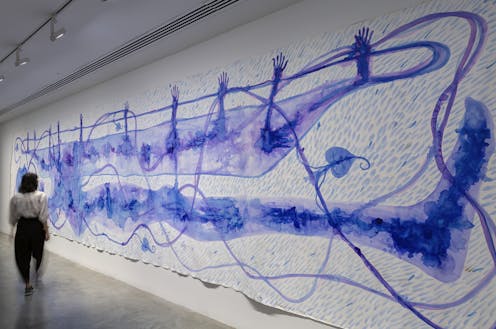
The Generous Water Giant, 2022. Courtesy Bandjoun Station & Galerie Lelong & Co. Installation view, 23rd Biennale of Sydney, rīvus, 2022, Museum of Contemporary Art Australia. Phot ography: Document Photography.
Review: the 23rd Biennale of Sydney, rīvus.
Artists for generations have shown vision and leadership in addressing society’s most wicked problems. Yet art by itself cannot change the world without a platform. International biennales are the most high-profile exhibition platforms of our times.
As the third oldest continuous international biennale, running since 1973, the Biennale of Sydney is one of the most authoritative and influential contemporary art exhibitions in the world.
Working collaboratively with a team of four Sydney-based curators from Arts & Cultural Exchange (ACE), Artspace, Museum of Contemporary Art (MCA) and the Art Gallery of NSW, the artistic director and Colombian curator José Roca has addressed some of the most pressing preoccupations of the day.
Specifically, the current 23rd edition shows how biennales can make a constructive contribution to debates around environmental sustainability and can advocate for a less ecologically combative inhabitation of Earth.
This is not a dry or didactic exhibition: it is rich with wonder, aesthetically captivating and, at times, viscerally immersive.
Equal status to science and art
Nyikina Warrwa woman Dr Anne Poelina recently co-authored an article about the growing recognition of the legal rights of rivers.
She is featured in one of several similar videos in the Biennale as the personification of the Martuwarra (Fitzroy) River.
The personhood of rivers is a key premise underpinning the entire 2022 Biennale, titled rīvus, or “stream” in Latin.
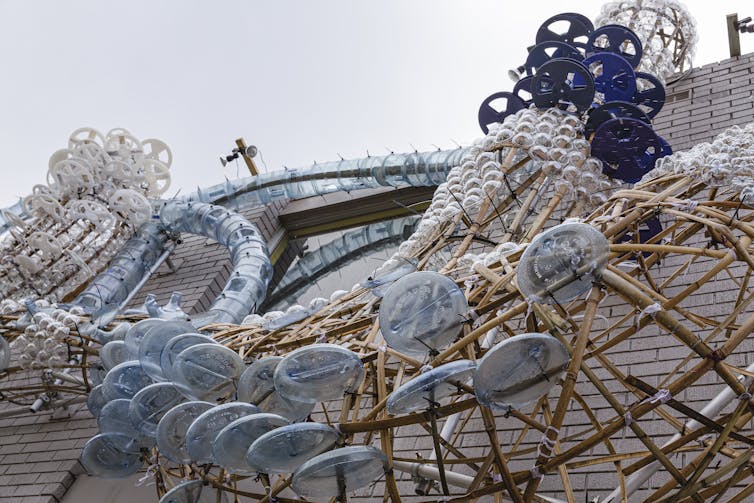
Photography: Document Photography.
At the entrance to each of the exhibition venues, a different river greets the viewer: its cultural significance and ecological woes embodied by a First Nations custodian narrator. It is a deft curatorial device that serves to link the exhibitions across Sydney and establish the equal status this biennale affords art, science, activism, traditional knowledge and bodies of water.
For the previous Biennale in 2020, artistic director Brook Andrew made a similar curatorial intervention with his “Powerful Objects” installation at each venue, which served to gently reiterate the exhibition’s postcolonial discourse.
Read more:
Sydney Biennale review: an incisive global perspective on deeper crises
This is just one element of continuity between the 2020 and 2022 editions; another is the foregrounding of First Nations cultural knowledge.
If biennales are to retain relevance in these difficult times, they must look to curatorial models that accumulate rather than discard strategies and knowledge gained with each edition.
By not wiping the slate entirely clean, the 2022 Biennale of Sydney strengthens messaging from the 2020 edition, key aspects of which were impacted by COVID-19 with closures and cancellations and for that reason also have been taken up by Roca and his team.
This signals a curatorial generosity not usually associated with biennales, more commonly perceived as the playground of individualistic artists and star curators.
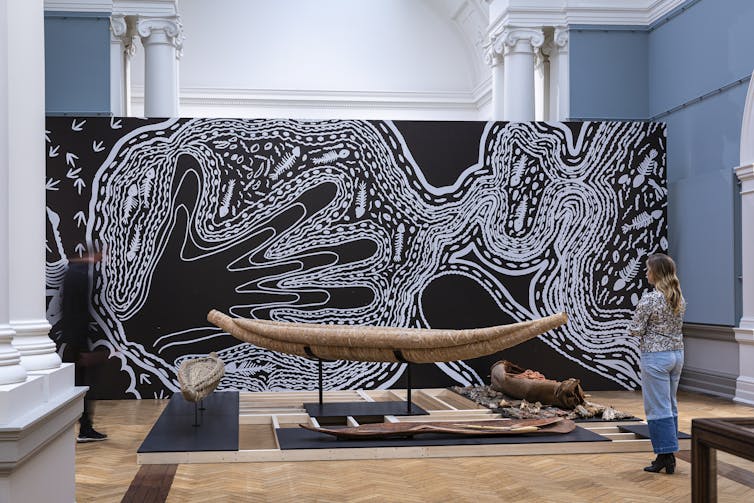
Photography: Document Photography
A legacy of oak trees
One former biennale legacy project built on in the 2022 edition is Joseph Beuys’ 7000 Oaks: City Forestation Instead of City Administration.
In 1982, Beuys – a German artist and environmental activist – launched the project by planting seeds for 7,000 oak trees in Kassel. In 1984, the planting of a single tree was commissioned for that year’s Biennale of Sydney.
Beuys’ work is referenced by two projects at the Art Gallery of NSW. The first is by English artist duo Ackroyd & Harvey, well known internationally for their ongoing tree-planting project Beuys’ Acorns, inspired by 7000 Oaks.

Photography: Document Photography
For the biennale they have created monumental “living” portraits of environmentalist Lille Madden and her grandfather Uncle Charles “Chicka” Madden. Made in Sydney from a variety of grasses, the commanding portraits are ephemeral like grass itself and will likely fade over time.
The second work connecting back to Beuys is One Beat One Tree. A digital interactive installation by the late Belgian artist Naziha Mestaoui, it invites visitors to “plant” and “grow” a tree with dance-like moves. While these trees grow on the screen, the work also has real-world reforestation outcomes.
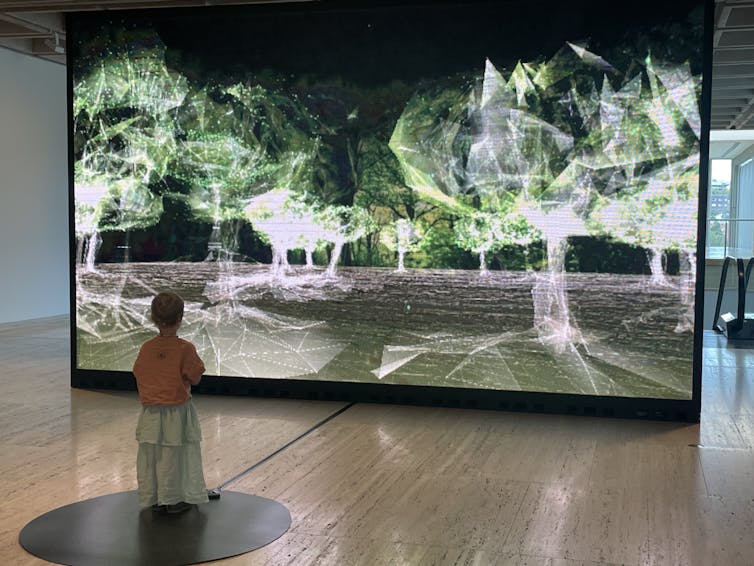
Felicity Fenner, Author provided
Another response to Beuys’ tree is being performed by artist Mike Parr this week.
The 2022 biennale’s homage to Beuys resuscitates Australia’s iteration of one of the world’s earliest and most iconic environmental artworks, which will be relaunched with the opening of Sydney Modern later this year.
Flow and connection
This seamless flow across time, cultures and natural environments epitomises the 22nd Biennale of Sydney, making it is near impossible to single out individual works as highlights.
Those that conjure the concepts of flow and interconnectedness, inherent to bodies of water, most clearly articulate the exhibition premise. There is Bernie Krause’s audio feast titled The Great Animal Orchestra and Cave Urban’s suspended bamboo river at Barangaroo.
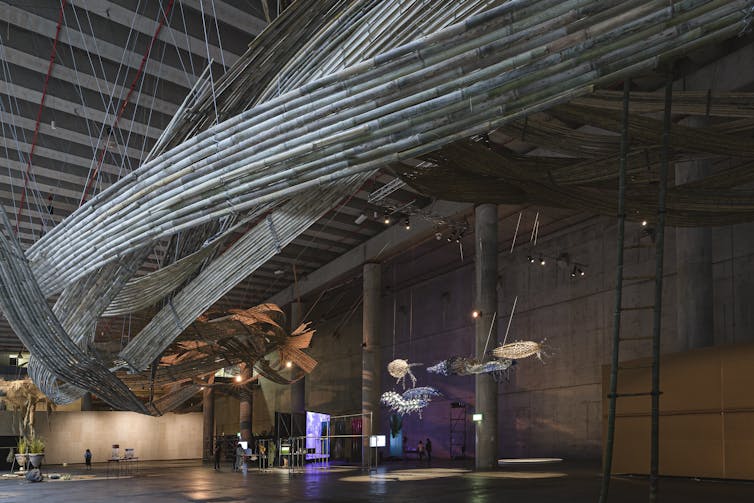
(detail). Courtesy the artist; Cave Urban, Flow, 2022 (detail). Courtesy the artists; Hera Büyüktaşçıyan, Fishbone IV, 2019- 2022 (detail). Courtesy the artist & Green Art Gallery, Dubai; and Ana Barboza and Rafael Freyre, Water ecosystem, 2019-2022 (detail). Courtesy the artists & Museode Arte Contemporáneo de Lima. Installation view, 23rd Biennale of Sydney, rīvus, 2022, The Cutaway at Barangaroo.
Photography: Document Photography.
Leanne Tobin’s film traces the journey of the Burramatta (Parramatta) River eels at ACE. Hannah Tuulikki’s equally hypnotic film depicts the artist singing to and swimming with seals in her native Scotland.
Carolina Caycedo’s expansive wall map of waterways at the National Art School Gallery is matched in its big picture vision by Barthélémy Toguo’s similarly sweeping painting, The Generous Water Giant, at the MCA.
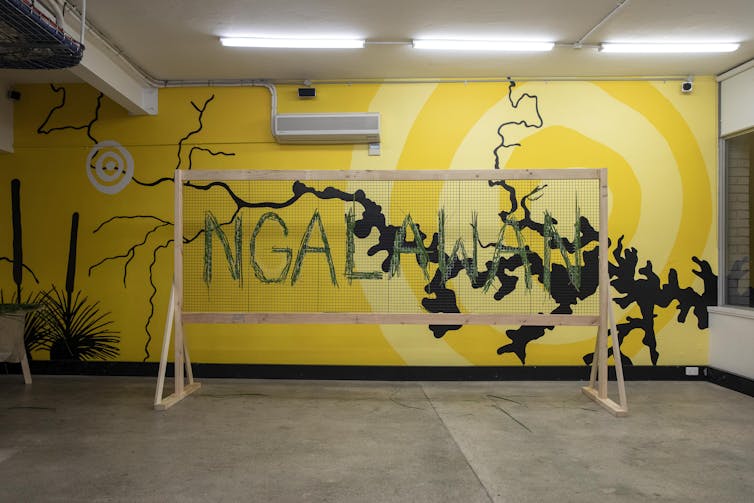
Photograph: Lyndal Irons
The accompanying publication, rīvus: a glossary of water, encapsulates the exhibition’s interdisciplinary approach in a way that, like the exhibition itself, is non-hierarchical and interwoven.
The 2022 Biennale of Sydney invites new audiences through its attention to those international issues also impacting Australia, and in its extensive participation with local artists and communities.
Though still very much part of the international biennale network, this exhibition has all the ingredients to offer Australian visitors inspiration and meaningfulness at a time when art and exhibitions are all too easily overshadowed by the global challenges we face.
The 23rd Biennale of Sydney, rīvus, is at various venues until June 13.
![]()
The author’s journal article “De-Beuysed But Not Forgotten: Joseph Beuys in Sydney” (Public Art Dialogue, NY, 2019) appears in the 2022 Biennale of Sydney publication, “rivus: a glossary of water”.
– ref. ‘Rich with wonder’: the 2022 Sydney Biennale finds connection and relevance in troubled times – https://theconversation.com/rich-with-wonder-the-2022-sydney-biennale-finds-connection-and-relevance-in-troubled-times-177133









